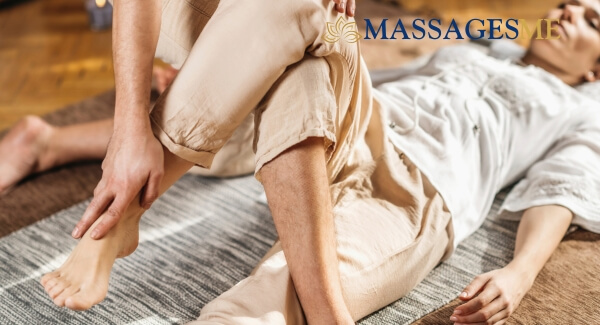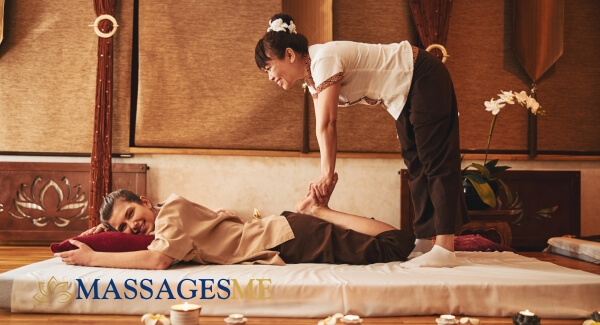How Thai Massage Can Help with Back Pain, Headaches, and Sciatica

Chronic pain affects millions of people worldwide, diminishing quality of life, limiting mobility, and creating cycles of frustration as sufferers search for effective relief. Whether it manifests as persistent back pain that makes daily activities challenging, recurrent headaches that disrupt concentration and enjoyment, or sciatic nerve pain that shoots down the leg with every movement, chronic pain demands attention and effective intervention.
Whilst conventional approaches often rely on pain medication, injections, or surgery, these treatments address symptoms rather than underlying causes and may carry significant side effects or risks. Thai massage offers a distinct approach: a holistic, non-invasive method that addresses the root causes of chronic pain through targeted stretching, acupressure, muscle manipulation, and energy work.
This article explores how Thai massage helps explicitly with three of the most common chronic pain conditions: back pain, headaches (including tension headaches and migraines), and sciatica. By examining the mechanisms through which Thai massage produces pain relief, reviewing the scientific evidence supporting its effectiveness, and providing practical guidance for incorporating this therapy into pain management strategies, we offer a comprehensive resource for those seeking natural, effective pain relief.
Understanding Chronic Pain: Why It Persists
Before exploring how Thai massage addresses specific pain conditions, it's valuable to understand what makes pain chronic and why it proves so resistant to conventional treatments.
Acute pain serves a protective function, alerting us to injury or damage and promoting healing behaviours. Once the tissues have healed, acute pain typically resolves. Chronic pain, however, persists beyond normal healing time, often lasting months or years. It may begin with an injury but continue long after tissues have healed, or it may develop gradually without a clear precipitating injury.
Several factors contribute to chronic pain:
Structural issues: Postural imbalances, joint restrictions, or tissue adhesions create ongoing mechanical stress that generates pain signals.
Muscle tension patterns: Chronic muscle contraction, often stress-related, creates persistent discomfort and restricts movement.
Neurological sensitisation: The nervous system can become hypersensitive, amplifying pain signals and creating pain in response to stimuli that shouldn't hurt.
Inflammation: Chronic low-grade inflammation in tissues perpetuates pain and impairs healing.
Compensatory patterns: When one area hurts, the body compensates by altering movement patterns, which creates new areas of strain and pain.
Psychological factors: Stress, anxiety, and depression both result from and contribute to chronic pain, creating feedback loops that maintain suffering.
Effective chronic pain management must address multiple dimensions simultaneously rather than targeting isolated symptoms. Thai massage's holistic approach makes it particularly suited to this complex challenge.
Thai Massage for Chronic Back Pain
Back pain represents one of the most common and debilitating chronic conditions, affecting approximately 80% of people at some point in their lives. For many, acute back pain becomes a chronic condition that significantly impacts work, recreation, and daily functioning.
The Mechanisms of Relief
Thai massage addresses back pain through multiple complementary mechanisms:
Passive stretching: One of Thai massage's most distinctive features is its extensive use of assisted stretches. For back pain, therapists guide recipients through positions that gently elongate the spine, stretch tight back muscles, and create space between vertebrae. These stretches address muscle shortening that contributes to spinal compression and pain.
The stretches work through several physiological processes:
- Mechanical lengthening of shortened muscle fibres
- Release of fascial restrictions that limit spinal mobility
- Improved joint range of motion
- Restoration of natural spinal curves
Acupressure along Sen lines: Thai therapists apply focused pressure along energy pathways that traverse the back, particularly Sen Sumana (the central line), Sen Ittha and Sen Pingkhala (parallel to the spine), and Sen Kalathari (which branches to various body regions, including the back).
This targeted pressure:
- Releases trigger points that refer pain to other areas
- Stimulates blood flow to chronically tight muscles
- Encourages natural healing processes
- Reduces muscle spasm and guarding
Rhythmic manipulation: Thai massage employs gentle rocking, compression, and mobilisation techniques that relax the nervous system and reduce muscle tone. This rhythmic quality signals safety to the body, allowing protective muscle tension to release.
Postural correction: Many cases of chronic back pain stem from postural imbalances. Thai massage addresses these by:
- Releasing chronically shortened muscles that pull the body out of alignment
- Stretching compensatory areas that have tightened due to poor posture
- Improving body awareness so recipients can recognise and correct postural habits
- Restoring balanced tension across the front and back of the body
Scientific Evidence for Back Pain Relief
Research consistently supports Thai massage's effectiveness for back pain:
Immediate pain reduction: Studies show that Thai massage produces significant immediate reductions in pain intensity. Recipients report decreased discomfort and improved mobility following single sessions.
Long-term improvements: Regular Thai massage sessions over several weeks produce cumulative benefits, with pain levels continuing to decrease and functional capacity improving. Research indicates these benefits persist for weeks after treatment ends.
Superior to conventional approaches: Comparative studies have found Thai massage more effective than standard care (rest, pain medication, physical therapy exercises) for certain types of back pain. The combination of stretching, pressure, and movement addresses multiple pain mechanisms simultaneously.
Improved disability scores: Beyond reducing pain intensity, studies document improved scores on disability questionnaires, indicating that recipients can perform more daily activities with less limitation.
Enhanced quality of life: Research participants consistently report improvements in quality of life measures, including better sleep, improved mood, and increased confidence in their ability to manage their condition.
Specific Applications for Different Back Conditions
Lower back pain: The most common complaint, often related to muscle strain, disc issues, or sacroiliac joint dysfunction. Thai massage focuses on:
- Hip and hamstring stretches to reduce lumbar stress
- Lower back muscle release
- Gluteal work to address compensatory tension
- Stretches that decompress the lumbar spine
Upper back and shoulder pain: Often related to desk work, driving, or stress. Treatment emphasises:
- Chest opening stretches to counteract forward posture
- Upper back and shoulder muscle release
- Neck and shoulder stretches
- Work along Sen lines connected to shoulder and arm function
Thoracic spine stiffness: The mid-back region often becomes restricted, limiting breathing and creating referred pain. Techniques include:
- Gentle spinal twists and rotation
- Rib mobilisation to improve breathing mechanics
- Stretches that restore thoracic extension
Thai Massage for Headaches and Migraines
Headaches, particularly tension headaches and migraines, significantly impact the quality of life for millions of sufferers. Many people struggle with frequent headaches that resist conventional treatment or require medication with unwanted side effects.
Understanding Headache Types
Tension headaches: The most common type, characterised by a band-like pressure around the head. They often relate to muscle tension in the neck, shoulders, and jaw, often accompanied by stress.
Cervicogenic headaches: Pain that originates from neck structures but is felt in the head. These often respond particularly well to bodywork addressing neck restrictions.
Migraines: Intense, often one-sided headaches frequently accompanied by nausea, light sensitivity, and visual disturbances. Whilst the mechanism is more complex than simple muscle tension, muscular and vascular factors contribute.
How Thai Massage Reduces Headache Frequency and Intensity
Thai massage addresses headaches through targeted techniques and systemic effects:
Neck and shoulder work: Most headaches involve tension in the neck and shoulder region. Thai massage releases this tension through:
- Gentle stretches that elongate chronically shortened neck muscles
- Acupressure on trigger points that refer pain to the head
- Mobilisation of neck joints to restore proper movement
- Release of upper trapezius and levator scapulae muscles (commonly tight in headache sufferers)
Pressure point stimulation: Specific points on the head, face, and neck relate to headache relief. Thai therapists work these areas with focused pressure, stimulating:
- Local blood flow
- Lymphatic drainage
- Nerve responses that interrupt pain signals
- Release of facial and scalp tension
Improved circulation: Thai massage techniques stimulate both blood and lymph circulation. For headaches, this means:
- Enhanced oxygen delivery to tissues
- Removal of inflammatory compounds
- Improved venous and lymphatic drainage from the head
- Reduced vascular congestion that contributes to migraines
Parasympathetic activation: Research shows Thai massage activates the parasympathetic nervous system, shifting the body from stress mode to rest mode. This is particularly relevant for headaches because:
- Stress is a primary headache trigger
- Parasympathetic activation reduces muscle tension
- Nervous system calming interrupts pain amplification
- Regular parasympathetic activation may prevent headache development
Jaw tension release: Many headache sufferers unconsciously clench their jaw, particularly during sleep or stress. Thai massage addresses this through gentle work on the temporomandibular joint (TMJ) and associated muscles.
Scientific Evidence for Headache Relief
Clinical research provides strong support for Thai massage's effectiveness:
Randomised controlled trials: Studies comparing Thai massage to control conditions have demonstrated significant reductions in headache intensity, frequency, and duration. One notable trial found that recipients experienced fewer headache days per month and reduced pain severity when headaches did occur.
Increased pain threshold: Research measuring pressure pain threshold (the amount of pressure required to produce pain) found that Thai massage increased this threshold, indicating reduced pain sensitivity in headache-prone areas.
Sustained benefits: Studies tracking participants over weeks and months found that benefits persisted beyond the immediate post-treatment period, suggesting that Thai massage produces lasting changes rather than merely temporary relief.
Medication reduction: Some research participants reported decreased need for headache medication following regular Thai massage sessions, indicating clinically meaningful improvement.
Quality of life improvements: Beyond pain reduction, studies document improvements in sleep quality, daily functioning, and emotional well-being for headache sufferers receiving Thai massage.
Preventive Benefits
Regular Thai massage sessions may prevent headache development by:
- Reducing baseline muscle tension
- Improving stress resilience
- Maintaining proper neck alignment and mobility
- Addressing trigger points before they generate referred pain
- Supporting overall nervous system regulation
Thai Massage for Sciatica and Nerve Pain
Sciatica describes pain that radiates along the path of the sciatic nerve, which runs from the lower back through the hips and buttocks and down each leg. This condition can be excruciating, with sharp, burning, or electric-shock sensations that significantly limit mobility and function.
Understanding Sciatica
Sciatica results from compression or irritation of the sciatic nerve, commonly caused by:
Herniated disc: When disc material presses on nerve roots
Spinal stenosis: Narrowing of the spinal canal that compresses nerves
Piriformis syndrome: Tightness in the piriformis muscle (deep in the buttock) that compresses the sciatic nerve
Muscle imbalances: Postural problems and compensatory patterns that create nerve compression
Inflammation: Swelling around nerve roots that increases pressure
How Thai Massage Addresses Sciatica
Thai massage's approach to sciatica focuses on creating space, reducing compression, and restoring proper movement patterns:
Loosening tight muscles: Several muscles can compress the sciatic nerve. Thai massage releases tension in:
- Piriformis muscle (the most common culprit in nerve compression)
- Gluteal muscles
- Hip rotator muscles
- Lower back muscles
- Hamstrings (which can become tight and pull on the pelvis)
Improving flexibility: Restricted range of motion in the hips and lower back contributes to sciatic pain. Thai massage employs extensive hip and leg stretches that:
- Open the hip joint
- Lengthen the hamstrings
- Stretch the IT band
- Mobilise the sacroiliac joint
- Restore spinal flexibility
Restoring balance: Sciatica often develops due to imbalances between the body's left and right sides or between anterior and posterior muscle groups. Thai massage addresses these by:
- Balancing tension across paired muscle groups
- Correcting pelvic tilts and rotations
- Addressing leg length discrepancies (often functional rather than structural)
- Releasing compensatory patterns
Deep tissue work: For chronic sciatic pain, deeper pressure may be necessary to reach muscles like the piriformis. Thai massage incorporates:
- Sustained pressure on deep gluteal muscles
- Slow, focused work that allows tissues time to release
- Techniques using elbows or knees for appropriate depth
- Patient, gradual progression that respects tissue tolerance
Targeted stretching: Specific stretches directly address sciatic nerve compression:
- Pigeon pose variations that open the hip and stretch piriformis
- Supine twists that mobilise the lower back
- Hamstring stretches that reduce posterior chain tension
- Hip flexor stretches that address anterior tightness
Creating space around the nerve: As muscles relax and joints mobilise, physical space around the sciatic nerve increases. This decompression:
- Reduces direct pressure on nerve tissue
- Improves blood flow to the nerve
- Allows inflammatory compounds to disperse
- Facilitates nerve healing
Evidence and Clinical Experience
Whilst research specifically on Thai massage for sciatica is more limited than for back pain or headaches, several lines of evidence support its use:
Clinical reports: Practitioners consistently report positive outcomes for sciatic clients, with many experiencing significant relief within several sessions.
Mechanism alignment: The known causes of sciatica (muscle tension, restricted mobility, nerve compression) align perfectly with Thai massage's therapeutic mechanisms.
Related research: Studies on massage for lower back pain and hip mobility demonstrate benefits for the same structures involved in sciatica.
Patient testimony: Many individuals with sciatica report that Thai massage provided relief when other approaches failed, particularly for piriformis syndrome.
Managing Sciatic Flare-Ups
For those with chronic sciatica, regular Thai massage can:
- Reduce the frequency of painful episodes
- Decrease the severity of flare-ups when they occur
- Shorten recovery time
- Improve overall function between episodes
- Build confidence in managing the condition
During acute flare-ups, treatment must be modified appropriately, often focusing on gentle work away from the most painful areas whilst addressing contributing factors.
Additional Benefits Beyond Pain Relief
Whilst direct pain reduction represents the primary goal, Thai massage produces several additional benefits that support chronic pain management:
Improved Circulation and Healing
Enhanced blood flow: Thai massage's rhythmic compression and stretching stimulate circulation, delivering oxygen and nutrients to tissues whilst removing metabolic wastes. This supports:
- Tissue repair and regeneration
- Reduced inflammation
- Improved cellular function
- Faster recovery from strain or injury
Lymphatic drainage: The gentle pressure and mobilisation encourage lymph movement, which:
- Reduces tissue swelling
- Removes inflammatory compounds
- Supports immune function
- Decreases pressure on pain-sensitive structures
Flexibility and Postural Improvements
Chronic pain often relates to restricted movement and postural imbalances. Thai massage systematically addresses these through:
Increased range of motion: Regular stretching progressively improves flexibility, reducing mechanical stress on joints and tissues.
Postural correction: By releasing muscles that pull the body out of alignment and stretching compensatory areas, Thai massage supports better posture, which reduces pain-generating mechanical stress.
Movement re-education: As restrictions release and balance improves, the body naturally adopts more efficient movement patterns, reducing strain.
Stress Reduction and Pain Perception
Pain and stress interact in complex ways. Stress increases pain perception, and pain can also cause stress. Thai massage breaks this cycle by:
Calming the nervous system: Parasympathetic activation reduces the stress response and its pain-amplifying effects.
Reducing muscle guarding: Stress-related muscle tension adds to pain from structural causes; releasing this tension reduces overall pain burden.
Improving emotional well-being: The compassionate attention and physical relief provided by Thai massage support better mood and reduced anxiety, which influence pain perception.
Enhancing pain coping: Regular sessions provide both physical relief and psychological support, improving confidence in managing chronic conditions.
Prevention of Pain Progression
Regular Thai massage can prevent chronic pain from worsening by:
- Maintaining flexibility and mobility
- Addressing emerging problems before they become severe
- Supporting tissue health through improved circulation
- Preventing compensatory patterns from developing
- Maintaining nervous system balance
Practical Considerations for Pain Management
To maximise chronic pain relief through Thai massage, several practical factors warrant attention.
Finding Qualified Practitioners
Pain management requires skilled, knowledgeable therapists who:
- Understand pain conditions: Knowledge of anatomy, pathology, and contraindications ensures safe, effective treatment.
- Can modify techniques: Different pain conditions and individual responses require treatment adaptation.
- Communicate effectively: Discussing your pain history, triggers, and responses enables therapists to tailor sessions more effectively.
- Work collaboratively: The best outcomes often involve coordination with other healthcare providers.
For those in the UK seeking practitioners experienced in pain management, you can find qualified Thai massage therapists in the UK who specialise in chronic pain conditions.
Treatment Frequency and Expectations
Initial intensive phase: For chronic pain, weekly sessions for 4-8 weeks often establish meaningful improvement.
Maintenance schedule: Once initial gains are achieved, sessions every 2-4 weeks maintain benefits.
Realistic expectations: Chronic conditions develop over time and rarely resolve instantly. Commitment to a course of treatment produces the best results.
Individual variation: People respond differently; some experience immediate dramatic relief, whilst others improve gradually over multiple sessions.
Communication During Treatment
Effective pain management requires clear communication:
Before sessions: Provide detailed pain history, including onset, triggers, what helps or worsens symptoms, and other treatments tried.
During sessions: Offer feedback about pressure, comfort, and sensations. Never endure pain that feels wrong or excessive.
After sessions: Report how you respond in the hours and days following treatment, including any changes in pain levels, mobility, or function.
Complementary Approaches
Thai massage works best as part of comprehensive pain management:
Movement practices: Yoga, tai chi, or other appropriate exercises help maintain gains and build strength.
Self-care: Stretching, heat/cold application, and stress management between sessions.
Professional care: Coordination with physiotherapists, chiropractors, or physicians when appropriate.
Lifestyle modifications: Addressing contributing factors like poor ergonomics, inadequate sleep, or nutritional deficiencies.
Contraindications and Cautions
Certain conditions require modified treatment or contraindicate Thai massage:
- Acute injury: Recent trauma needs medical evaluation before massage.
- Severe disc herniation: Some cases require medical management before bodywork is appropriate.
- Nerve damage: Significant neurological symptoms warrant medical assessment.
- Infections or malignancy: These require medical treatment first.
- Uncontrolled medical conditions: Certain cardiovascular, bleeding, or bone conditions may contraindicate treatment.
Always disclose all health conditions to your therapist and maintain open communication with healthcare providers.
Conclusion: A Holistic Path to Pain Relief
Chronic pain conditions like back pain, headaches, and sciatica affect millions of people, significantly diminishing quality of life and limiting daily function. Whilst conventional approaches offer various interventions, they often address symptoms rather than underlying causes and may carry significant side effects or limitations.
Thai massage provides a fundamentally different paradigm: a holistic, non-invasive approach that addresses the multiple dimensions of chronic pain simultaneously. Through its unique combination of passive stretching, targeted acupressure, rhythmic manipulation, and energy work, Thai massage releases muscle tension, improves mobility, enhances circulation, calms the nervous system, and supports the body's natural healing processes.
The scientific evidence increasingly supports what traditional practitioners have known for centuries: Thai massage produces measurable, clinically meaningful improvements in chronic pain conditions. Research documents have shown reduced pain intensity, improved function, decreased medication needs, and enhanced quality of life for individuals suffering from back pain, headaches, and sciatica.
Perhaps most importantly, Thai massage empowers people with chronic pain by providing a safe, effective tool they can incorporate into comprehensive self-management strategies. Regular sessions not only provide temporary relief but also build lasting improvements in tissue health, flexibility, postural alignment, and nervous system regulation, which support long-term pain reduction.
For those who have tried multiple approaches without satisfactory relief, or who seek natural, holistic pain management that addresses root causes rather than merely masking symptoms, Thai massage offers a time-tested, evidence-supported path forward. The journey from chronic pain to improved function and quality of life begins with that first session and continues through committed engagement with this ancient healing art.
Search Massage Therapists Near You.
More From Our Blog
Latest Blogs
Post-Thai Massage Care: Tips for Maximizing the Benefits After Your Session
Thai Massage for Beginners: Answering Common Questions for Your First Session
Choosing the Right Thai Massage Therapist: What to Look for in a Qualified Professional
Post-Thai Massage Care: Tips for Maximising the Benefits After Your Session
Preparing for Your Thai Massage: Tips on What to Wear and How to Get Ready
How to Talk to Your Therapist for the Best Thai Massage Experience
What to Expect During a Traditional Thai Massage Session
A Guide to How Thai Massage Techniques Can Correct Postural Issues
How Thai Massage Can Help with Back Pain, Headaches, and Sciatica
The Mental and Emotional Benefits of a Thai Massage Session
View All Blogs
Advertise with Massages Me and Grow Your Business!
We are the leading massage platform for massage therapists in London and across the UK covering all of England, Scotland, Wales and Northern Ireland. Our aim is to promote individual therapists and venues in the UK, and help professional and casual body workers providing therapeutic and relaxing massages to expand their businesses and build desirable client base.
We provide a friendly and reliable online advertising platform for qualified Masseuses, students, and salons to connect with potential clients looking for relaxing and therapeutic massages - onsite and offsite mobile services across the UK.
Are you looking to meet more customers? Get your profile listed and start getting bookings today!



